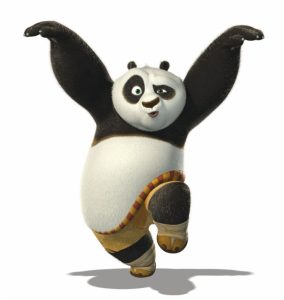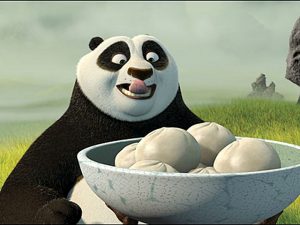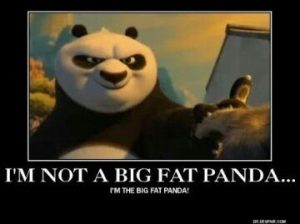Apparently Kung Fu Panda is considered a good movie. I don’t think my dad thought so as he grumbled as he walked out of the theater with my sister and I, at the time aged 9 and 7. But, probably to my dad’s surprise, not only was Kung Fu Panda very popular in the United States, it was also a big hit in China, which serves as the setting and aesthetic for the animated film. In addition to being set in China, the movie incorporates a lot traditional Chinese elements and symbols—Kung Fu and pandas, for example. Those familiar with the fiercely waged battles over cultural appropriation will be unsurprised to hear that this American-made movie using Chinese culture provoked controversy. “The movie is nearly perfect,” said Chinese director Lu Chuan, noting that the creators “showed a very sincere attitude about Chinese culture” (Lee). Taking a rather different standpoint, Chinese artist Zhao Bandi said the movie “twisted Chinese culture and served as a tool to kidnap the minds of the Chinese people” (Lam). So, which is it—dangerous cultural appropriation or sincere engagement with Chinese culture?
Of course, those responsible for the movie would say the latter. They called the film “a love letter to China” (Jörg & Zhao, 111). Many elements of the movie could plausibly point to that conclusion. Obviously the movie features a panda, the Chinese national symbol, and Kung Fu, which is an important part of China’s cultural history. The movie starts out with hand-drawn animations that closely mimic classic Chinese art and the scenery is  filled with temples and other symbols that clearly let the viewer know that they are in China. Its cast includes Chinese American actors, as well as Jackie Chan, ever a feature of Kung Fu movies. In an effort to maintain authenticity in the fight scenes, the animators were given martial arts lessons (Chung). One Chinese academic, Bu Xiao-yan finds evidence to support the filmmakers’ claim, saying that the correct uses of Chinese words “spread the traditional Chinese specialties, symbols, values, and so forth, filling the movie with thick Chinese flavor” (Bu, 880). Bu also talks about the oblique presence of Taoist and Confucian beliefs, along with the presence of traditional Chinese elements, such as noodles, sedan chairs, lanterns and acupuncture (Bu, 881). Realistically, the elements of Chinese culture in this movie are not much more than flavor and props. The plot and characters reveal a very different perspective about the movie. Kung Fu Panda follows an overweight, immature, panda who, much to everyone’s surprise and dismay, is chosen to be the legendary Dragon Warrior. With the help of wise masters, he becomes a Kung Fu warrior, defeats an evil leopard, brings peace to the valley, and—of course—discovers that everyone is special and you just have to believe in yourself. None of this is Chinese. In fact, it is distinctly not Chinese.
filled with temples and other symbols that clearly let the viewer know that they are in China. Its cast includes Chinese American actors, as well as Jackie Chan, ever a feature of Kung Fu movies. In an effort to maintain authenticity in the fight scenes, the animators were given martial arts lessons (Chung). One Chinese academic, Bu Xiao-yan finds evidence to support the filmmakers’ claim, saying that the correct uses of Chinese words “spread the traditional Chinese specialties, symbols, values, and so forth, filling the movie with thick Chinese flavor” (Bu, 880). Bu also talks about the oblique presence of Taoist and Confucian beliefs, along with the presence of traditional Chinese elements, such as noodles, sedan chairs, lanterns and acupuncture (Bu, 881). Realistically, the elements of Chinese culture in this movie are not much more than flavor and props. The plot and characters reveal a very different perspective about the movie. Kung Fu Panda follows an overweight, immature, panda who, much to everyone’s surprise and dismay, is chosen to be the legendary Dragon Warrior. With the help of wise masters, he becomes a Kung Fu warrior, defeats an evil leopard, brings peace to the valley, and—of course—discovers that everyone is special and you just have to believe in yourself. None of this is Chinese. In fact, it is distinctly not Chinese.
Take the main character, Po the panda. Voiced by Jack Black, Po is portrayed as fat and immature from the very start of the movie, where, upon waking up, he struggles to stand up. After achieving that task, he greets his action figures, bewildering his neighbors. He is living with his father, a goose, who expects him to take over the noodle shop, even though Po dreams of  becoming a Kung Fu master. When he is accidentally chosen as the Dragon Warrior, he is ridiculed for his weight, clumsiness, and lack of hygiene. Eventually, he trains to become a master, but can only do so if he is incentivized by food. Jack Black essentially plays the same character in every movie he does. Kung Fu Panda is no different. Po is not differentiable from the unattractive, deadbeat, immature characters that Black is known for. Po and Black become “inseparable, if not identical, through the composite of sound and image” (Chung). Po’s facial expressions, body, and movements also mimic Black’s. These characteristics are quintessentially American. We Americans are known to be overweight, lazy, and consumptive—not to mention brash and, perhaps, immature—and Po clearly reflects that.
becoming a Kung Fu master. When he is accidentally chosen as the Dragon Warrior, he is ridiculed for his weight, clumsiness, and lack of hygiene. Eventually, he trains to become a master, but can only do so if he is incentivized by food. Jack Black essentially plays the same character in every movie he does. Kung Fu Panda is no different. Po is not differentiable from the unattractive, deadbeat, immature characters that Black is known for. Po and Black become “inseparable, if not identical, through the composite of sound and image” (Chung). Po’s facial expressions, body, and movements also mimic Black’s. These characteristics are quintessentially American. We Americans are known to be overweight, lazy, and consumptive—not to mention brash and, perhaps, immature—and Po clearly reflects that.
Before closely examining this movie, I imagined that the Kung Fu training would make Po somehow more Chinese. After the training montage, Po turns down the food that he has finally won through his hard work. Yet, his character never changes after that point, and in fact Po affirms his Americanness in the final fight scene. His opponent belittles him as “just a big fat panda,” and as he delivers the final blow, Po proclaims, “I’m not a big fat panda, I’m THE big fat panda” (Kung Fu Panda). This brash affirmation of self is not only an indication that Po retains his American qualities, but also an American act in it of itself. The US is not subtle about its patriotism, and Po’s affirmation of his American qualities (i.e. his weight) is evocative of that.
But, not only is the main character American: the film’s overall message of individualism is aggressively American as well. Po immediately stands out. He’s a panda with a goose for a father in a community that is almost exclusively comprised of pigs, bunnies, and geese. However, all of the other Kung Fu masters—and therefore main characters—are also the only example of their species represented in the movie. So the characters who stand out from the crowd are the heroes of the movie. But maybe that’s not convincing. The movie’s morals are more telling. Po begins the movie as a directionless fanboy who wanted he was someone else. When he is chosen as the Dragon Warrior, he worries that he’s inherently incapable of becoming a Kung Fu master—that he isn’t good enough. But (of course) he discovers something important: you just have to believe in yourself. When he receives the Dragon Scroll—thought to contain the secret to never-before-seen Kung Fu power—and finds that it is blank, everyone is confused and dismayed. Similarly, the Secret Ingredient to Po’s father’s Secret Ingredient Soup is (you guessed it) nothing. There is no special secret; every individual is special—you just have to believe in yourself. This is textbook American participation trophy culture. It’s part of an ideology that tells children, “You can grow up to be whatever you want” and, “we’re all winners!” Don’t believe it? Try googling “millennials individualism” and you’ll find a plethora of articles in The Atlantic and The New York Times decrying the end of the community and declaring millennials to be self-centered narcissists. Apparently our parents told us that we were special too frequently. Whether or not you believe the hype, individualism is certainly seen as an American value, particularly in contrast to stereotypes about the Chinese. One of the main forms of Western, anti-Asian xenophobia is the notion of the yellow horde or yellow peril; Americans fear East Asians because of their sheer numbers. Central to the notion of the yellow horde is the image of the faceless masses taking over the world, which stands in contrast to the hyper-individualism of America. Generally, the Chinese are perceived to be more community and family oriented. In Chinese, the family name comes before the individual’s name, which represents the promotion of the group over the individual. So Kung Fu Panda’s morals are explicitly American. What do we make of the Chinese elements? As one academic who studies images of China in American film put it, “China is reduced to a series of visual motifs” while “at a still deeper level, America—at least American values and sensibilities—is felt at every turn” (Greene, 199). Though many elements are Chinese, they have been stripped of their true meanings and filled with American meanings. China is reduced to “a visual one-dimensional landscape that has severed all connections with a ‘real’ place or ‘real’ people” (Greene, 199).
Should we be alright with the fact that Chinese culture is stolen, reduced to scenery and subjected to American morals? Bu says yes. He says that Kung Fu Panda—neither totally Chinese nor totally American—is a “transcultural version” which “represents a unique way in which the world’s cultures are being hybridized to form what can be called a global culture” (884). He sees the movie as “a good way to spread traditional cultures and enhance effective exchanges with other cultures to reach a far better international cooperation and communication” (884). According to Bu, it’s “a win-win situation” (884). But this assumes that Kung Fu Panda treats both cultures equally. The film’s morals don’t reflect that. An already American character becomes more American. More importantly, Kung Fu Panda promotes American culture at the expense of Chinese culture. It superimposes American ideas onto important Chinese symbols. Though Chinese aspects are included, they are stripped of their meaning and subordinated for American ideals. This represents a form of cultural domination, which is literally sold back to the culture being dominated. These days, China is one of the major threats to American world influence an important. As many Americans fear economic dominance from China, it’s no surprise that American culture would push back and assert its supremacy. Though the filmmakers may have attempted to engage genuinely with Chinese culture, the end product reduces Chinese culture to props and symbols, and in doing so, asserts that American individualism is better than Chinese collectivism. They—very successfully— sold back a low-fat, lite, version of Chinese culture, which has been reduced to accommodate American individualism. So, good movie? Maybe—I’m sure Uncle Sam would love it.
This essay was read by Noah Nsangou, written in the style of Ellen Willis, and responds to prompt #3.
Works Cited
Bu, Xiao-yan. “An Intercultural Interpretation of Kung Fu Panda—From the Perspective of Transculturation.” Sino-US English Teaching 9.1 (2012): 878-85. David Publishing Company. Web. 18 May 2017.
Chung, Hye Jean. “Kung Fu Panda: animated animal bodies as layered sites of (trans)national identities.” Velvet Light Trap, no. 69, 2012, p. 27+. Academic OneFile, libraries.state.ma.us/login?gwurl=http://go.galegroup.com/ps/i.do?p=AONE&sw=w&u=mlin_w_willcoll&v=2.1&it=r&id=GALE%7CA281175224&asid=80aa4c8984cb282d611bcdf3d7e5d891. Accessed 18 May 2017.
Greene, Naomi. From Fu Manchu to Kung Fu Panda: Images of China in American Film. Honolulu: U of Hawaiʻi Press, 2014. Print.
Huber, Jörg, and Chuan Zhao, eds. A New Thoughtfulness in Contemporary China: Critical Voices in Art and Aesthetics. Bielefeld: Transcript, 2011. Google Books. Google. Web. 18 May 2017.
Kung Fu Panda. Dir. Mark Osborne and John Stevenson. Perf. Jack Black, Angelina Jolie, Dustin Hoffman, Lucy Liu, Jackie Chan, Seth Rogen, David Cross. Dreamworks, 2011.
Lam, Andrew. “Chinese Culture and the Politics of “Kung Fu Panda”.” New America Media. N.p., 15 June 2011. Web. 18 May 2017. <http://newamericamedia.org/2011/06/chinese-culture-and-the-politics-of-kung-fu-panda.php>.
Lee, Min. “‘Kung Fu Panda’ reaches Chinese box office milestone.” USA Today. Gannett Satellite Information Network, 03 July 2008. Web. 18 May 2017.


